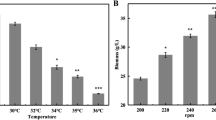Abstract
4-Methyl-5-pentylbenzene-1,3-diol (MPBD), a product of the polyketide synthase SteelyA, is a signaling molecule that regulates Dictyostelium discoideum development. During early development, MPBD controls chemotactic cell aggregation by regulating the expression of genes in the cAMP signaling pathway; however, during culmination at late development, it induces spore maturation. In the present study, we analyzed the effects of MPBD, its derivatives, and a putative MPBD-derived metabolite on developmental defects in the MPBD-less stlA null mutant. Using structure–activity relationship studies, it was observed that in MPBD, the functional groups that were essential for induction of spore maturation were different from those essential for induction of cell aggregation. Dictyoquinone, a putative MPBD metabolite rescued the aggregation defect in stlA null mutant in early development, but not the spore maturation defect at the later stage. Our data suggest that MPBD regulates chemotactic cell aggregation and spore maturation via different mechanisms.




Similar content being viewed by others
References
Escalante R, Vicente JJ (2000) Dictyostelium discoideum: a model system for differentiation and patterning. Int J Dev Biol 44:819–835
Kuwayama H, Kubohara Y (2009) Differentiation-inducing factor-1 and -2 function also as modulators for Dictyostelium chemotaxis. PLoS ONE 4:e6658. https://doi.org/10.1371/journal.pone.0006658
Nichols JM, Veltman D, Kay RR (2015) Chemotaxis of a model organism: progress with Dictyostelium. Curr Opin Cell Biol 36:7–12. https://doi.org/10.1016/j.ceb.2015.06.005
Kay RR, Thompson CR (2009) Forming patterns in development without morphogen gradients: scattered differentiation and sorting out. Cold Spring Harb Perspect Biol 1:a001503. https://doi.org/10.1101/cshperspect.a001503
Kessin RH (2001) Dictyostelium: evolution, cell biology, and the development of multicellularity, vol 38. Cambridge University Press, Cambridge
Konijn TM, Van De Meene JG, Bonner JT et al (1967) The acrasin activity of adenosine-3′,5′-cyclic phosphate. Proc Natl Acad Sci U S A 58:1152–1154
Loomis W (1975) Dictyostelium discoideum: A developmental system. Academic Press, New York
Narita TB, Koide K, Morita N et al (2011) Dictyostelium hybrid polyketide synthase, SteelyA, produces 4-methyl-5-pentylbenzene-1,3-diol and induces spore maturation. FEMS Microbiol Lett 319:82–87. https://doi.org/10.1111/j.1574-6968.2011.02273.x
Narita TB, Chen ZH, Schaap P et al (2014) The hybrid type polyketide synthase SteelyA is required for cAMP signalling in early Dictyostelium development. PLoS ONE 9:e106634. https://doi.org/10.1371/journal.pone.0106634
Oohata AA, Fukuzawa M, Hotta R et al (2009) Differentiation inducing factors in Dictyostelium discoideum: a novel low molecular factor functions at an early stage(s) of differentiation. Dev Growth Differ 51:743–752. https://doi.org/10.1111/j.1440-169X.2009.01133.x
Takaya Y, Hotta R, Fujiwara K et al (2014) Alkylbenzoquinone involved in development of cellular slime molds. Org Lett 16:3660–3663. https://doi.org/10.1021/ol5014119
Murata C, Ogura T, Narita S et al (2016) Synthesis and SAR of 4-methyl-5-pentylbenzene-1,3-diol (MPBD), produced by Dictyostelium discoideum. Bioorg Med Chem Lett 26:1428–1433. https://doi.org/10.1016/j.bmcl.2016.01.067
Watts DJ, Ashworth JM (1970) Growth of myxameobae of the cellular slime mould Dictyostelium discoideum in axenic culture. Biochem J 119:171–174
Austin MB, Saito T, Bowman ME et al (2006) Biosynthesis of Dictyostelium discoideum differentiation-inducing factor by a hybrid type I fatty acid-type III polyketide synthase. Nat Chem Biol 2:494–502. https://doi.org/10.1038/nchembio811
Sato YG, Kagami HN, Narita TB et al (2013) Steely enzymes are involved in prestalk and prespore pattern formation. Biosci Biotechnol Biochem 77:2008–2012. https://doi.org/10.1271/bbb.130294
Kikuchi H, Oshima Y, Ichimura A et al (2006) Anti-leukemic activities of Dictyostelium secondary metabolites: a novel aromatic metabolite, 4-methyl-5-n-pentylbenzene-1,3-diol, isolated from Dictyostelium mucoroides suppresses cell growth in human leukemia K562 and HL-60 cells. Life Sci 80:160–165. https://doi.org/10.1016/j.lfs.2006.08.034
Acknowledgements
We would like to thank Mr. Shuhei Narita (Sophia University) for performing preliminary experiments. We would like to thank Dr. Kei Inouye and Dr. Akiko Oohata for their valuable comments and suggestions for this work.
Funding
This study was funded by JSPS KAKENHI [Grant Number 15K01807] to T.S. and a Sophia University Collaborative Research Grant (to T.S. and T.U.).
Author information
Authors and Affiliations
Corresponding author
Ethics declarations
Conflict of Interest
The authors declare that they have no conflict of interest.
Additional information
Publisher’s Note
Springer Nature remains neutral with regard to jurisdictional claims in published maps and institutional affiliations.
Electronic supplementary material
Below is the link to the electronic supplementary material.
Rights and permissions
About this article
Cite this article
Kondo, A.P., Narita, T.B., Murata, C. et al. 4-Methyl-5-Pentylbenzene-1,3-Diol Regulates Chemotactic Cell Aggregation and Spore Maturation Via Different Mechanisms in Dictyostelium discoideum. Curr Microbiol 76, 376–381 (2019). https://doi.org/10.1007/s00284-019-01639-2
Received:
Accepted:
Published:
Issue Date:
DOI: https://doi.org/10.1007/s00284-019-01639-2




